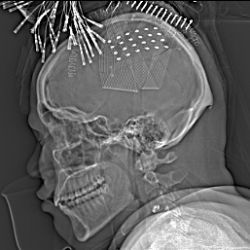
The news was inspiring: a Dutch man, diagnosed as comatose for 23 years, showed signs of brain response. But when he was "interviewed" on television late last year, observers quickly wondered if the words were his, or those of the "facilitator" helping direct his finger to the keyboard. In the future, researchers hope to let such "locked-in" patients communicate more directly, by eavesdropping on their brain signals.
The least invasive techniques exploit signals outside the body. But neurologist Jerry Shih of the Mayo Clinic in Jacksonville, FL, cautions that the electrical signals, such as those used for electro-encephalography, degrade in passing through the skull and tissue, so they are only good for simple actions like operating a remote control.
As an alternative, Shih and his colleagues enlisted several patients who had already been fitted with electrodes directly on the surface of their brains to treat epilepsy. The resulting "electro-corticography" measurements indicated clearly when a subject paid attention to particular letters flashing on a screen. These clues could help patients spell out words, even though the electrodes were not placed over the area of the brain that specializes in speech. "Brain signals from areas outside of the language cortex may contain enough information to be translated effectively into language," Shih says.
In spite of these successes, such a large-scale measurement of brain activity still carries only limited information, says neuroscientist John Donoghue of Brown University. "That ‘field potential’ signal reflects input from thousands, if not millions, of neurons," he says. In contrast, he and his colleagues have been monitoring chips, each containing dozens of electrodes, implanted directly in the relevant areas of the brain. Each electrode measures the action potentials, or "spikes," produced by individual nerve cells. "That is the information language of the brain." Donoghue says.
Merely by thinking about moving their hand, subjects can point and click, giving them access to everything computers can do. "All four people that we’ve studied have been able to control a cursor," Donoghue says. Although the startup that originally sponsored the activity has moved on, the project continues, recently adding wireless transmission of brain signals to external equipment, which will be critical for patients to use the technology in real life.
In principle, implanted electronics could also pre-process the signals. Electrical engineer Rahul Sarpeshkar of MIT has been designing low-power electronics that does this using a probabilistic decoding scheme "where every spike matters," not just the average rate. Sarpeshkar is confident that implanted brain-machine interfaces will help many patients. "The proof-of-concept science has been done, and it’s actually moving now to the stage where we have to engineer the system so that it’s clinically useful. That takes time."
For now, the list of engineering challenges is long. "Until the technology becomes more robust and is proven over a wide range of subjects," Shih says, "it would be difficult to justify from a moral and medical standpoint."



Join the Discussion (0)
Become a Member or Sign In to Post a Comment